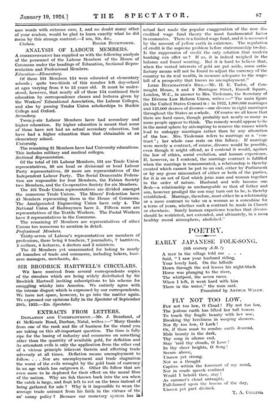ANALYSIS OF LABOUR MEMBERS.
A cosuFsroNDENT has supplied us with the following analysis of the personnel of the Labour Members of the House of Commons under the headings of Education, Sectional Repre- sentation and Professional Members.
Education—Elementary.
Of these 191 Members 134 were educated at elementary schools.; quite two-thirds of this number left day-school at ages varying from 9 to 13 years old. It must be under- stood, however, that nearly all of these 134 continued their education by correspondence classes and lectures given by the Workers' Educational Association, the Labour Colleges, and also by passing Trades Union scholarships to Ruskin College and Oxford.
Secondary.
Twenty-six Labour Members have had secondary and higher education. By higher education is meant that some of those have not had an actual secondary education, but have had a higher education than that obtainable at an elementary school.
University.
The remaining 31 Members have had University educations. This includes military and medical colleges.
Sectional Representation.
Of the total of 191 Labour Members, 101 are Trade Union representatives, 89 are local or divisional or local Labour Party representatives, 39 more are representatives of the Independent Labour Party. The Social Democratic Federa- tion are responsible for four Members, the Fabian Society two Members, and the Co-operative Society for six Members.
The 101 Trade Union representatives are divided amongst the numerous Trade Unions. The Miners' Federation have 45 Members representing them in the House of Commons. The Amalgamated Engineering Union have only 4. The National Union of Railwaymen have 3. Fifteen more are representatives of the Textile Workers. The Postal Workers have 8 representatives in the Commons.
The remaining 27 Members are representatives of other Unions too numerous to mention in detail.
Professional Members.
Thirty-seven of Labour's representatives are members of professions, there being 8 teachers, 7 journalists, 7 barristers, 5 authors, 4 lecturers, 4 doctors and 2 ministers.
The 52 Members yet unaccounted for belong to nearly all branches of trade and commerce, including bakers, busi- ness managers, merchants, &c.










































 Previous page
Previous page